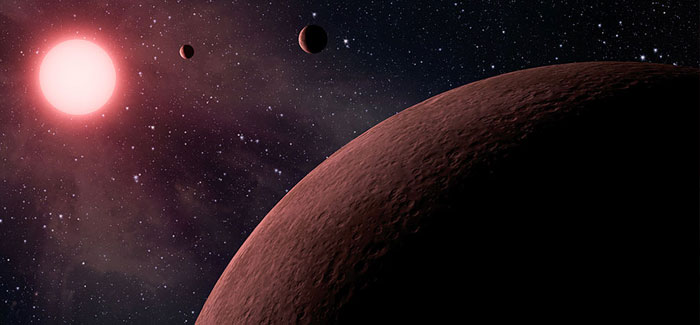
Astronomers using data from NASA’s Kepler mission and ground-based telescopes recently confirmed that the system called KOI-961 hosts the three smallest exoplanets known so far to orbit a star other than our sun. An exoplanet is a planet that resides outside of our solar system. (Rendering courtesy NASA/JPL-Caltech)
Planets originally thought too hot to sustain life might be just right.
Ever since I made a model solar system in elementary school using painted Styrofoam balls, string, and a coat hanger, I’ve been obsessed with planets. So when I had the opportunity to speak with the new dean of physical sciences Rocky Kolb, of course I asked about the Giant Magellan Telescope (GMT).
UChicago is partnered with nine other universities and research institutes to build the supergiant earth-based telescope in the Chilean Andes that will provide images ten times sharper than those from Hubble. “I think the Giant Magellan Telescope will be poised to discover life on another planet outside of our solar system,” Kolb says. And he wants the University of Chicago to make that discovery.
The GMT will give us eyes on the ground when it becomes functional in about a decade, and when NASA launches the James Webb Space Telescope, Hubble’s successor, in 2018, there will be eyes in the sky. But we need to know where to look, and Department of Geophysical Sciences professor Dorian Abbot is drawing a better map using predictive models (PDF).
Red dwarf stars are smaller and cooler than our own sun, and they are by far the most common type of star in the Milky Way. Because red dwarfs are so common, it made sense to create search models for inhabitable planets based on their type of solar systems. The area where terrestrial planets with the necessary atmospheric pressure can sustain surface liquid water is called the circumstellar habitable zone (HZ), sometimes called the Goldilocks zone. This is where we think life is most likely to be found.
Previous estimates of where the HZ begins and ends were based on global climate models that took into account the way energy gets absorbed, distributed, and reflected from the earth. But those models could not predict cloud behavior, which can warm a cold planet and cool a hot one. Planets close to red dwarfs are typically tidally locked, meaning one side of the planet always faces the sun, leading to perpetual day and perpetual night in opposite hemispheres. New 3-D models that can incorporate cloud behavior have now been applied to the inner range of the HZ. They predict that the sun-facing side of water-bearing terrestrial planets would be mostly covered by clouds, which would have a temperature-stabilizing feedback effect and produce a suitable climate.
These calculations may increase the size of the Goldilocks zone, doubling the number of potentially life-sustaining, red dwarf–orbiting terrestrial planets to roughly 60 billion in the Milky Way alone. And there are at least 100 billion other galaxies. That’s a lot of Styrofoam balls.
